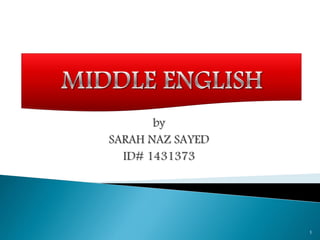
Middle English
- 1. by SARAH NAZ SAYED ID# 1431373 1
- 2. Letter ‘v’: - • No standard English word starts with ‘v’. • ‘Very’ is not an English word. • It was introduced in Middle English. • Before 1066, we had only ‘f’. • Ex: drifan driven ‘v’ & ‘u’:- • When ‘v’ comes in the middle of a word, it was written ‘u’. • Ex: ever euen 2
- 3. ‘hw’ to ‘wh’ • Ex: cild child • This change was introduced by Norman tribes. Addition of ‘h’ after ‘c’:- ‘sc’ (sounds ‘sk’) to ‘sh’ • Ex: sceal (OE) sheal (ME) shall (MnE) • This was introduced by Norman tribes as well. Omission of ‘h’ from ‘hl’, ‘hn’, ‘hr’ • Ex: hwat what • ‘hw’ is phonetically more accurate as ‘wh’. 3 • Ex: hleapen leapen (to leap) • ‘h’ got omitted. • ‘en’ was no more in use (inflectional endings). So it got omitted later as well. • leapen leap
- 4. Omission of ‘w’ between a consonant and a back vowel • Consonant, particularly ‘s’ or ‘t’. • Ex: swa so twa to Transformation of ‘g’ • ‘g’ became ‘w’ placed after the consonant ‘l’ or ‘r’. • ‘g’ got it original sound in ME. • Ex: morgen morwen (morrow) OE prefix ‘ge’ became ‘i’ Inflectional ‘n’ was lost 4 • Ex: gelimpan ilimpan (to happen) • Ex: min faðer my fader an ewte a newt
- 5. ‘ӯ’ [ü:] changed to [i:] 5 • OE long vowel sounds ē, ī, ō, ū remained unchanged but their spelling changed. Ex: fēt feet fōda food • Ex: hӯdan (OE) hīden (ME) ‘y’ [ü] changed to [i] • Same as above.
- 6. ‘ā’ became [ɔ:] • [ɛ:] were written both ‘e’ and ‘ee’ in ME. • Later in MnE, [ɛ:] was written as ‘ea’. • Ex: brɛ:θ breath ‘æ’ became ‘a’ • ‘e’ was dropped. • Ex: glæd glad [æ:] became [ɛ:] 6 • It was spelt with ‘o’ or double ‘o’ (oo). • Ex: stān (OE) st[o/oo]n (ME, pronounced [ɔ]) stone (MnE, pronounced [o]).
- 7. NOUN • In the strong masculine declension, singular mūð, mūðes, mūðe, mūð and plural mūðas, mūða and mūðum, mūðas were reduced to only three forms : mūð, mūðes, and mūðe (to the mouth). • ‘-s’ and ‘-es’ refer to plurality in MnE. • Exception of plural nouns: deer, feet, oxen, childen 7 Middle English was known as ‘The Period of Leveled Inflection’ because most of the inflections were lost during that time.
- 8. ADJECTIVE • all adj. inflections fall together as -e; • The indication of number, gender and case were lost. • The declensions were gradually lost • Ex: blinda blind blinde blind PRONOUN • ‘this’ is a MnE word. • In OE, it has 3 forms : þēs, þēos, þis 8
- 9. • ‘woman’ was a masculine gender in OE. Ex: wīf-mann (because the 2nd element of the word is masculine) • ‘woman’ was a feminine gender in ME. • The role of grammatical gender in OE was beginning to decline by 11th century. • ‘the’ came to be used generally as a definite article. • ‘that’ is used as a demonstrative article. • There was not any grammatical gender in ME. 9
- 10. 10 ASSIMILATION • The new French words were quickly assimilated. • Ex: gentle (French) gently (English) faith (French) faithful (English) SYNONYMS • Sometimes a French word completely replaced an Old English word . Ex: firen was replaced by crime. eam was replaced by uncle. The French language didn’t retain its originality after it entered into English Language French language didn’t change the grammar of English Language but OE started to lose its features.
- 11. PREFIX & SUFFIX • Many of the Old English prefixes gradually lost their vitality, their ability to enter into new combinations. • Prefixes no more in use: to-, be-, a- • Prefixes used today: un-, im-, counter-, dis-, re-, trans-, over-, under- • A similar decline is observable in the formative power of certain suffixes that were widely used in Old English. • Suffixes no more in use: -de, -by • Suffixes which are still in use: noun suffix –ness adjective endings -ful, -less, -some, -ish 11
- 12. 12 Below are some of the French words widely used in English Language today. Governmental & administrative words • govern • noble Ecclesiastical words • religion • theology Law • crime • banish
- 13. Social Life • curtain • couch Art • painting • sculpture Medicine • physician • remedy 13 Army and Navy • battle • combat Fashion • gown • cape Meals • mackerel • mutton
- 14. THANK YOU! 14